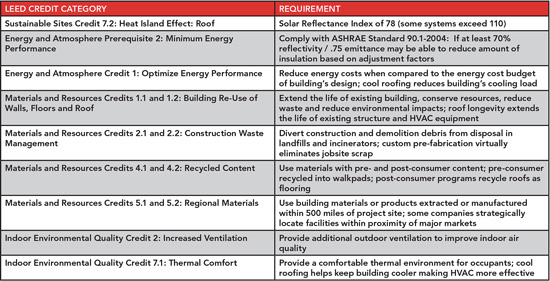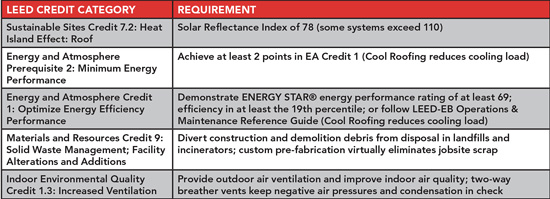This CE Center article is no longer eligible for receiving credits.
What are Cool Roofs?
Among the solutions to decrease energy use and thus decrease emissions from burning fossil fuels are cool roofing systems. Cool roofs use a highly reflective surface to direct a significant portion of solar heat from the sun away from the building. Unlike a dark or non-reflective roof surface that absorbs and transfers solar heat into the building and the surrounding neighborhood, a light-colored, reflective roof surface reflects and drives solar heat away from the building and into the atmosphere or beyond. Reflecting the sun’s energy to keep cool is an ancient strategy that has been made modern with science and innovation. Cool roofs have been widely available in the U.S. marketplace for more than 25 years.
Cool roofs can be achieved using a wide variety of roofing technologies, including single-ply membranes, cool-surfaced modified asphalt systems, and metal roofing panels. A wide variety of roof coatings may be applied to many different roofing surfaces. For any of these roofing products to be “cool” by today’s standards, the minimum percentage of solar heat reflected away from the building typically falls within a range of 0.50 (50 percent) to 0.70 (70 percent), depending on the particular standard being applied and the aging of the sample tested. The table to the left shows the most-recognized building codes and standards.iv
Benefits of Cools Roofs
The cheapest roof is rarely the least expensive. While the upfront cost of the cheapest roof possible may appeal to an owner, the long-term benefits that will be sacrificed makes it a very bad bargain. While budget may seem like the overriding concern, the primary goal should be to design and construct a watertight roofing system as well as a superior building that will not only create a healthier and more comfortable environment for occupants, but will save the owner or operator money and trouble in the long run. In many cases, educating the owner is necessary so that the best decision for long-term benefits can be made.
There are compelling “talking points” that explain the real costs and benefits of a cool roof:
- Insulation is from 25 to 50 percent more effective. When insulation gets hot, it is less effective at doing what it is supposed to do—slow heat movement through the surface. The science shows that extremely high temperatures reduce the effective R-value of the most widely used types of insulation (Leonard & Leonard, 2005).
- Improved HVAC efficiency. Inlet air temperature can be 5 degrees to 15 degrees cooler 30 inches above the roof surface. Most HVAC units are designed with efficiency ratings evaluated at 95 degrees (York International, 2005).
- Reduced heat flux. Studies from Princeton University show with modeling and field tests that reflectivity noticeably reduces heat flux on roofs with as much as R-48 insulation. The authors conclude that cool roofs make sense because they save in the summer and don’t really affect winter heating, especially in roofs with high levels of insulation.v
- Ambient interior temperatures can be 15 to 20 degrees cooler than outside with a cool roof. According to a report by the Lawrence Berkeley National Laboratory and other researchers: “In many commercial buildings, thermal conditions are not controlled well due to insufficient cooling or heating capacity, high internal or external loads, large thermal zones, improper control-system design or operation, or other factors.” The results of the study on worker productivity show that performance increases with temperature up to 70 to 71 degrees Farenheit, and decreases with temperature above 73 to 74 degrees Fahrenheit. The highest productivity is a temperature of around 71 to 72 degrees Fahrenheit. For example, at the temperature of 86 degrees Fahrenheit the performance is only 91.1 percent of the maximum, with the reduction in performance of 8.9 percent. In short, cool roofs can contribute to lowering the interior temperature and maintaining comfort levels for the occupants.
Reducing Peak Demand
Analysis of energy bills shows that peak demand charges accounts for a significant portion of monthly electric bills across the United States and that cool roofs provide an equally significant opportunity to reduce these charges when installed on air-conditioned buildings.
A sharp peak in electrical demand can be observed in buildings during the busiest hours of the day. Although a share of this peak may be attributed to equipment use in the building, a significant portion is caused by increased demand for air-conditioning in the heat of the afternoon. This peak in demand requires additional power plant capacity, leads to a greater chance of brownouts and blackouts, and may result in increased air pollution.
But most importantly for your client, the building owner, peak demand may result in monthly charges many times higher than the base electrical rates. One of the best approaches to shrink peak demand is to reduce the heat load on a building, especially the solar load that drives the need for air-conditioning. Few heat-reduction strategies can match the energy-saving potential of modern cool roofing technology. Click here for more information on reducing peak electrical demand.

Photo courtesy of Duro-Last, Inc.
Rooftop HVAC equipment has been shown to work more efficiently in combination with a cool roof.
Cool Roofs and Urban Heat Islands
Heat islands are those urban areas where the temperatures will be hotter than the surrounding areas. Lawrence Berkeley National Laboratory (LBNL) has been the main research agency and proponent of heat island mitigation activities.vii
As the chart below shows, on average the difference in afternoon temperatures between rural and urban land is 7 degrees Fahrenheit. In some areas, the difference is as much as 10 degrees Fahrenheit. This difference can increase during extended heat waves.
Three key factors make up the overwhelming majority of the 7-degree heat island difference:
- Fifty-six percent of the effect is due to less vegetation in the urban land compared to rural land (about 4 degrees).viii
- Dark paving causes 6 percent of the difference (less than ½ degree).
- Thirty-eight percent is directly attributed to dark roofing (almost 3 degrees).
Let’s consider the possible solutions to heat islands. Adding vegetation will certainly help. However, it is a long-term improvement, requiring 10, 20, even 50 years to reap full benefits of, for instance, mature leafy trees. Such a remedy is constantly in a catch-up mode because construction and expansion continually removes vegetation.
Replacing dark pavement with lighter-colored paving could also have a positive effect. Indeed, technology to make lighter pavement exists. But this is also a long-term solution and requires significant capital outlays for somewhat minimal benefit.
However, replacing dark roofing with light, reflective cool roofing provides the biggest bang for the buck. By raising reflectivity, we can offset the warming impact. Relative to other possible mitigations measures, it is easy to accomplish, relatively inexpensive, and provides immediate benefits to lessen the impacts of heat islands on a heating planet.

Image courtesy of the Environmental Protection Agency
This chart shows that on average the difference between rural and urban areas is 7 degrees Fahrenheit, with some areas as much as 10 degrees hotter. This difference can increase during extended heat waves.vi
How Cool Roofing Systems Are Rated
Following the long trend toward verifiable results that has arisen in the sustainable building industry, the Cool Roof Rating Council (CRRC) was created in 1998 “to develop accurate and credible methods for evaluating and labeling the solar reflectance and thermal emmitance (radiative properties) of roofing products and to disseminate the information to all interested parties.”ix
To become certified by CRRC, manufacturers must have their products tested and rated. The U.S. Department of Energy’s ENERGY STAR® program also offers a certification process for cool, reflective roofing.x
Many scientists agree that the planet is warming quicker than the natural forces of nature have ever brought about, and those scientists maintain that such quickening is caused in large part by human activity.
As the planet warms, the world’s population continues to move into urban areas that are heating up at twice the rate of global warming due to human activity, lack of vegetation, and the use of dark roofing and paving materials.
This article discusses the role of cool, reflective roofing, and specifically the role of PVC roofing as a way to decrease energy use and thereby decrease emissions. PVC single-ply roofing deflects heat from buildings, decreases energy use, mitigates urban heat islands, and serves as a durable platform for photovoltaic systems and vegetative roofs.
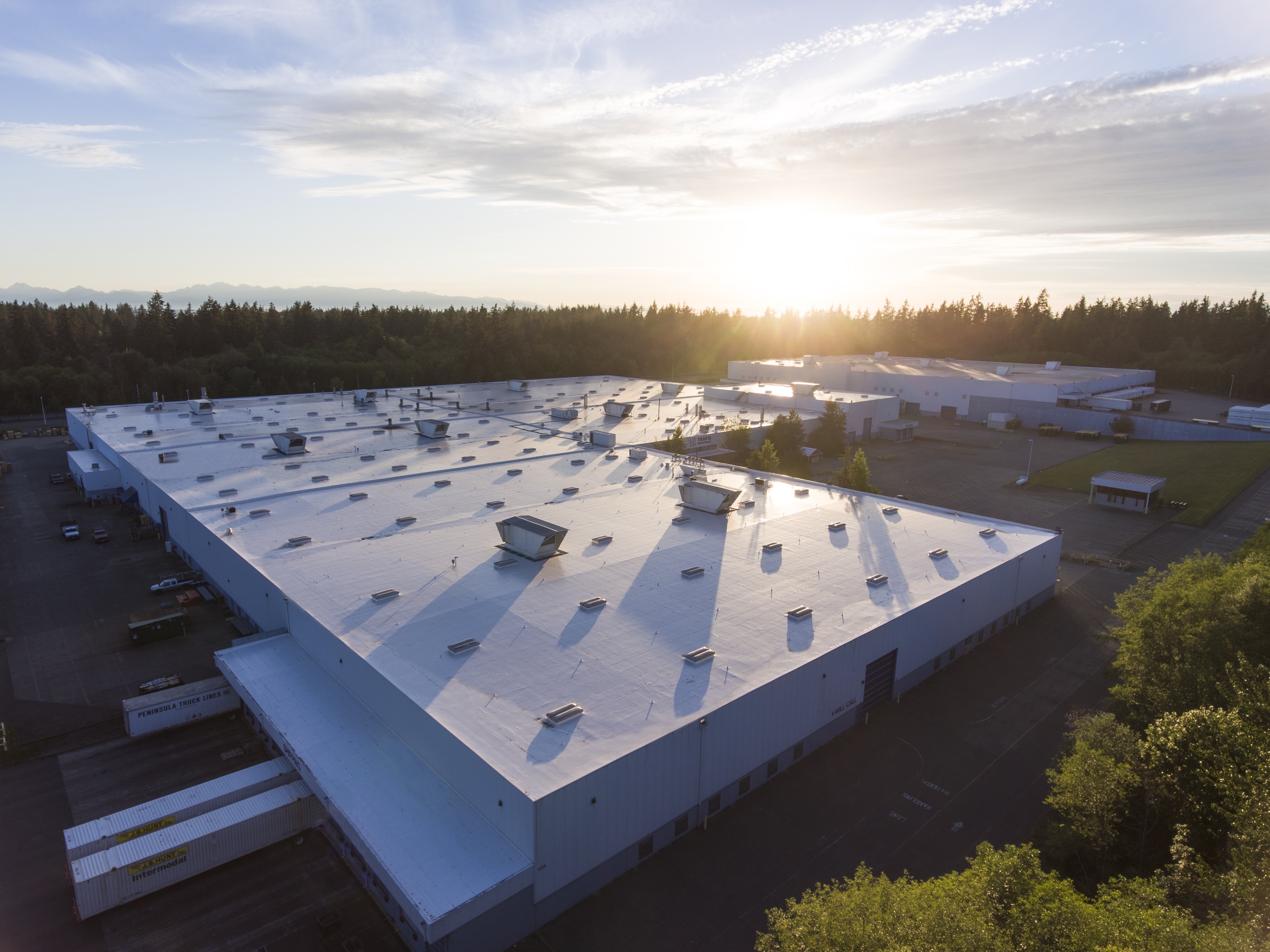
Photo courtesy of Duro-Last, Inc.
As the planet heats and cities heat even further, cool roofing systems are an effective method to keep buildings cool, protect insulation and substrates, and deflect solar energy back into the atmosphere and beyond.

Image courtesy of NASA’s Earth Observatory
This line plot shows yearly temperature anomalies from 1880 to 2018, indicating rapid warming in the past few decades, with the past decade the warmest.
What is a Hot Planet?
We have always lived in a greenhouse of sorts. The atmosphere traps the heat of the sun, which allows living beings to live and thrive. Many scientists maintain the expansion of that greenhouse effect, via gases that block solar heat from escaping back out of the atmosphere, causes the planet to heat up at a rate too quickly for nature to adapt.i The U.S. Dept. of Defense considers climate change “an urgent and growing threat to our national security”.ii
Earth's global surface temperature in 2018 was the fourth warmest since 1880, according to independent analyses by NASA and the National Oceanic and Atmospheric Administration (NOAA). The past five years are, collectively, the warmest years in the modern record.
According to NASA, the world’s leading climate research agency: “Multiple studies published in peer-reviewed scientific journals show that 97 percent or more of actively publishing climate scientists agree: Climate-warming trends over the past century are very likely due to human activities. In addition, most of the leading scientific organizations worldwide have issued public statements endorsing this position.”
Those issuing statements regarding climate include: the American Chemical Society, the American Medical Association, U.S. National Academy of Sciences, American Geophysical Union, American Meteorological Society, and the Intergovernmental Panel on Climate Change.iii
Additionally, cities are growing at an incredible rate worldwide—and they are heating up at a faster rate than global averages. They are particularly vulnerable to heat-related issues like air quality and health issues from heat. While most people don’t think about roofs, they can be 25 percent to 30 percent of total city area, making them a significant platform for urban sustainability that most people never have to interact with or notice. But roofs can be a part of the solution of hot cities. Roofs tend to be replaced more frequently than a building is retrofitted, so the rate of change (and rate of results) can be relatively quick. In short, smart roof usage is a climate strategy because it is immediately effective across a broad spectrum of benefits, and can be rolled out relatively quickly with good policy and good business decisions.
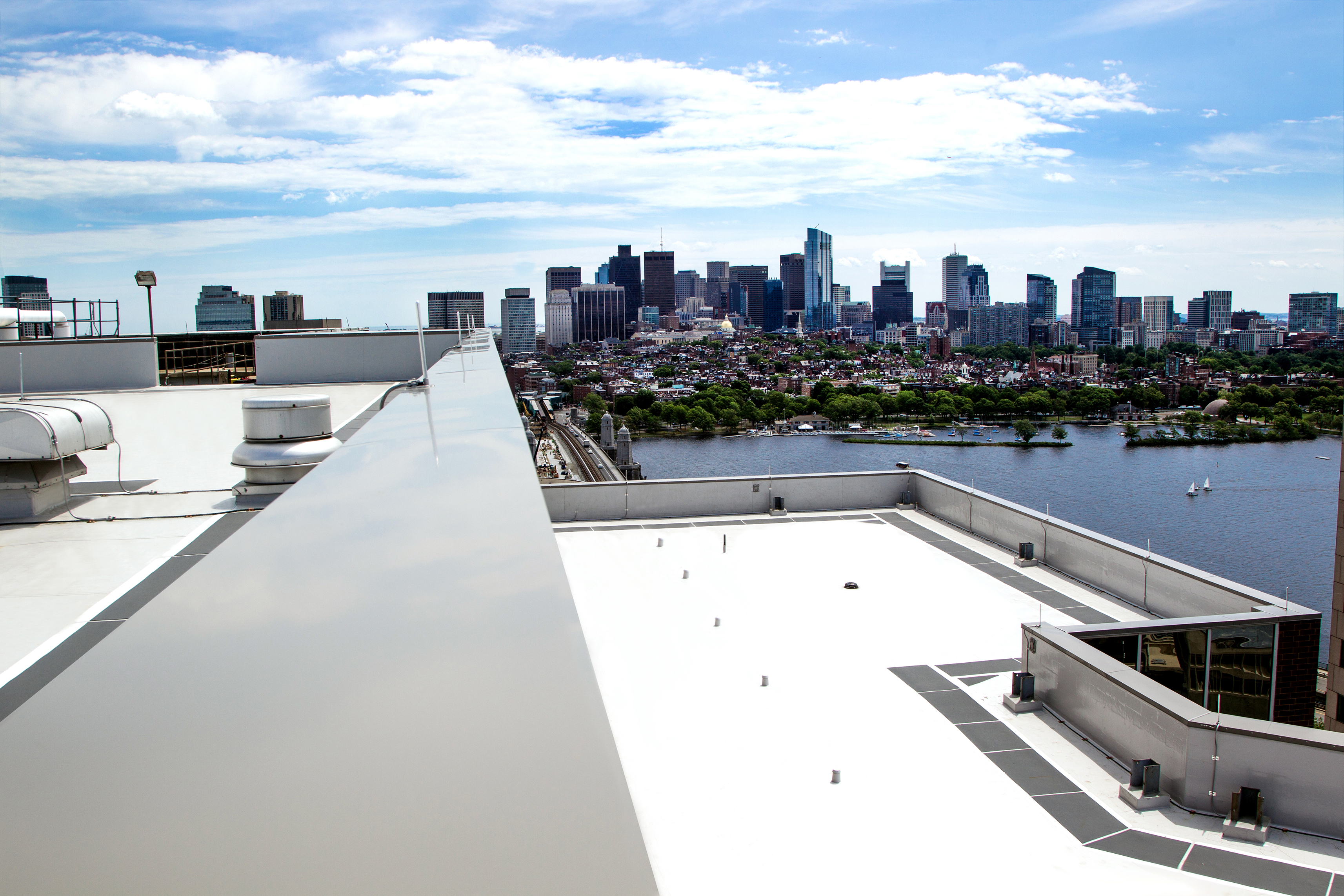
Photo courtesy of Duro-Last, Inc.
Cool roofs deflect solar energy away from a building and back to the atmosphere and beyond.
What are Cool Roofs?
Among the solutions to decrease energy use and thus decrease emissions from burning fossil fuels are cool roofing systems. Cool roofs use a highly reflective surface to direct a significant portion of solar heat from the sun away from the building. Unlike a dark or non-reflective roof surface that absorbs and transfers solar heat into the building and the surrounding neighborhood, a light-colored, reflective roof surface reflects and drives solar heat away from the building and into the atmosphere or beyond. Reflecting the sun’s energy to keep cool is an ancient strategy that has been made modern with science and innovation. Cool roofs have been widely available in the U.S. marketplace for more than 25 years.
Cool roofs can be achieved using a wide variety of roofing technologies, including single-ply membranes, cool-surfaced modified asphalt systems, and metal roofing panels. A wide variety of roof coatings may be applied to many different roofing surfaces. For any of these roofing products to be “cool” by today’s standards, the minimum percentage of solar heat reflected away from the building typically falls within a range of 0.50 (50 percent) to 0.70 (70 percent), depending on the particular standard being applied and the aging of the sample tested. The table to the left shows the most-recognized building codes and standards.iv
Benefits of Cools Roofs
The cheapest roof is rarely the least expensive. While the upfront cost of the cheapest roof possible may appeal to an owner, the long-term benefits that will be sacrificed makes it a very bad bargain. While budget may seem like the overriding concern, the primary goal should be to design and construct a watertight roofing system as well as a superior building that will not only create a healthier and more comfortable environment for occupants, but will save the owner or operator money and trouble in the long run. In many cases, educating the owner is necessary so that the best decision for long-term benefits can be made.
There are compelling “talking points” that explain the real costs and benefits of a cool roof:
- Insulation is from 25 to 50 percent more effective. When insulation gets hot, it is less effective at doing what it is supposed to do—slow heat movement through the surface. The science shows that extremely high temperatures reduce the effective R-value of the most widely used types of insulation (Leonard & Leonard, 2005).
- Improved HVAC efficiency. Inlet air temperature can be 5 degrees to 15 degrees cooler 30 inches above the roof surface. Most HVAC units are designed with efficiency ratings evaluated at 95 degrees (York International, 2005).
- Reduced heat flux. Studies from Princeton University show with modeling and field tests that reflectivity noticeably reduces heat flux on roofs with as much as R-48 insulation. The authors conclude that cool roofs make sense because they save in the summer and don’t really affect winter heating, especially in roofs with high levels of insulation.v
- Ambient interior temperatures can be 15 to 20 degrees cooler than outside with a cool roof. According to a report by the Lawrence Berkeley National Laboratory and other researchers: “In many commercial buildings, thermal conditions are not controlled well due to insufficient cooling or heating capacity, high internal or external loads, large thermal zones, improper control-system design or operation, or other factors.” The results of the study on worker productivity show that performance increases with temperature up to 70 to 71 degrees Farenheit, and decreases with temperature above 73 to 74 degrees Fahrenheit. The highest productivity is a temperature of around 71 to 72 degrees Fahrenheit. For example, at the temperature of 86 degrees Fahrenheit the performance is only 91.1 percent of the maximum, with the reduction in performance of 8.9 percent. In short, cool roofs can contribute to lowering the interior temperature and maintaining comfort levels for the occupants.
Reducing Peak Demand
Analysis of energy bills shows that peak demand charges accounts for a significant portion of monthly electric bills across the United States and that cool roofs provide an equally significant opportunity to reduce these charges when installed on air-conditioned buildings.
A sharp peak in electrical demand can be observed in buildings during the busiest hours of the day. Although a share of this peak may be attributed to equipment use in the building, a significant portion is caused by increased demand for air-conditioning in the heat of the afternoon. This peak in demand requires additional power plant capacity, leads to a greater chance of brownouts and blackouts, and may result in increased air pollution.
But most importantly for your client, the building owner, peak demand may result in monthly charges many times higher than the base electrical rates. One of the best approaches to shrink peak demand is to reduce the heat load on a building, especially the solar load that drives the need for air-conditioning. Few heat-reduction strategies can match the energy-saving potential of modern cool roofing technology. Click here for more information on reducing peak electrical demand.

Photo courtesy of Duro-Last, Inc.
Rooftop HVAC equipment has been shown to work more efficiently in combination with a cool roof.
Cool Roofs and Urban Heat Islands
Heat islands are those urban areas where the temperatures will be hotter than the surrounding areas. Lawrence Berkeley National Laboratory (LBNL) has been the main research agency and proponent of heat island mitigation activities.vii
As the chart below shows, on average the difference in afternoon temperatures between rural and urban land is 7 degrees Fahrenheit. In some areas, the difference is as much as 10 degrees Fahrenheit. This difference can increase during extended heat waves.
Three key factors make up the overwhelming majority of the 7-degree heat island difference:
- Fifty-six percent of the effect is due to less vegetation in the urban land compared to rural land (about 4 degrees).viii
- Dark paving causes 6 percent of the difference (less than ½ degree).
- Thirty-eight percent is directly attributed to dark roofing (almost 3 degrees).
Let’s consider the possible solutions to heat islands. Adding vegetation will certainly help. However, it is a long-term improvement, requiring 10, 20, even 50 years to reap full benefits of, for instance, mature leafy trees. Such a remedy is constantly in a catch-up mode because construction and expansion continually removes vegetation.
Replacing dark pavement with lighter-colored paving could also have a positive effect. Indeed, technology to make lighter pavement exists. But this is also a long-term solution and requires significant capital outlays for somewhat minimal benefit.
However, replacing dark roofing with light, reflective cool roofing provides the biggest bang for the buck. By raising reflectivity, we can offset the warming impact. Relative to other possible mitigations measures, it is easy to accomplish, relatively inexpensive, and provides immediate benefits to lessen the impacts of heat islands on a heating planet.

Image courtesy of the Environmental Protection Agency
This chart shows that on average the difference between rural and urban areas is 7 degrees Fahrenheit, with some areas as much as 10 degrees hotter. This difference can increase during extended heat waves.vi
How Cool Roofing Systems Are Rated
Following the long trend toward verifiable results that has arisen in the sustainable building industry, the Cool Roof Rating Council (CRRC) was created in 1998 “to develop accurate and credible methods for evaluating and labeling the solar reflectance and thermal emmitance (radiative properties) of roofing products and to disseminate the information to all interested parties.”ix
To become certified by CRRC, manufacturers must have their products tested and rated. The U.S. Department of Energy’s ENERGY STAR® program also offers a certification process for cool, reflective roofing.x
Brief History of Modern Roofing
For many decades, traditional asphalt roofing construction was the norm. Asphalt roofs experience little expansion or contraction, which means there were no thermal shock issues to consider. There was little concern for insulation and heat loss. Air-conditioning use was minimal or was not very costly. Therefore, summer heat retention was of not much concern.
Single-ply membrane products appeared in the early 1970s. Over the past few decades, scientists and product manufacturers developed better knowledge of chemical interactions and have introduced plasticizers and stabilizers into single-ply membranes, which prolong material life. At this point, the single-ply roofing industry has a proven performance record of more than 30 years.
As with any product, the quality of the components affects overall performance.
Types of Membrane Roofing
There are more types of membrane roofing than many architects realize. Modified bitumen, for example, is asphalt-based and blended with styrene-butadiene-styrene or atactic polypropylene. This product is a hybrid of traditional BUR (built-up roofing).
Thermoset membranes are “vulcanized,” which means the molecules are cross-linked, making polymers elastic. However, these materials become “set” so they are difficult to bond to each other. That means they cannot be softened and bonded by heat. Therefore, seaming requires adhesives. These include EDPM, Neoprene, and CSPE (Hypalon).
Thermoplastics will “flow” when heated because the molecules are not cross-linked. That means the seams can be heat welded or solvent welded. Ingredients used in compounding can include PVC resin, plasticizers, stabilizers, pigments, and fillers.
These materials are represented by a somewhat bewildering array of abbreviations: PVC, CPA, EIP, NBP, CPE, PIB, and TPO.
The big players of thermoplastics, however, are TPO (thermoplastic polyolefin) and PVC (polyvinylchloride).
TPOs are relatively new in the field, with most having been installed in the last 20 years. The ASTM standard for TPO is ASTM D 6878-03 for TPO Based Sheet Roofing.
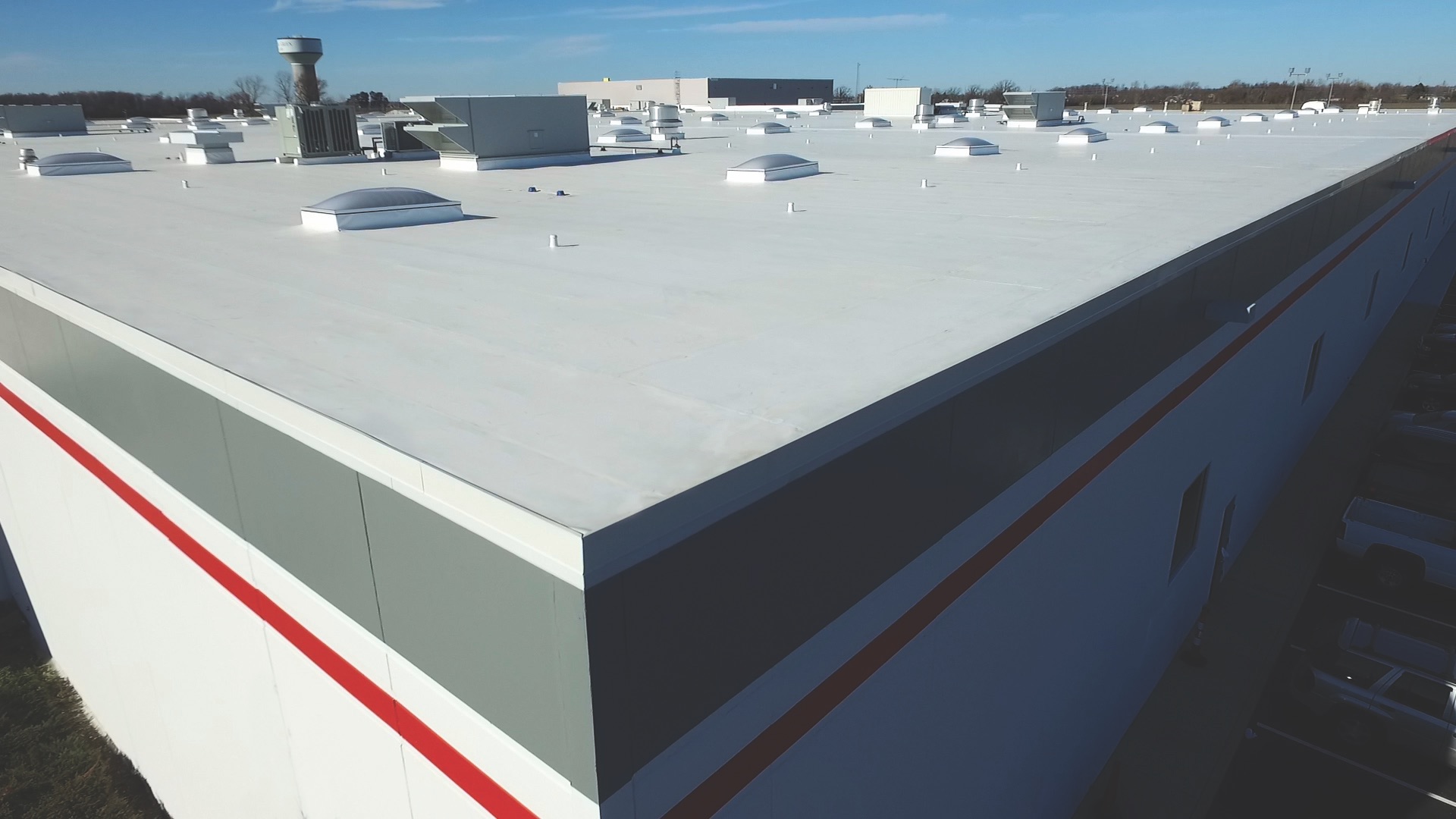
Photo courtesy of Duro-Last, Inc.
PVC membranes can be custom fabricated to fit each roof and penetration.
PVC Membranes
PVC roofing membranes have a much longer history than TPO roofing. PVC’s were introduced in Europe in the early 1960s and a decade later in the United States. PVC roofing systems can be installed on virtually any type of structure in any geographic location. Installations may be on dead flat, low-slope or sloped applications. Of course, it is always good roofing design and installation practice to make sure that water drains properly. However, because vinyl roofing uses no adhesives for seaming and is impervious to water, standing water that frequently occurs on flat roofs will not compromise the integrity of most vinyl systems.
PVC membranes are flexible and lightweight. Because of this, they can be custom-made to fit each roof and can be easily prefabricated. Prefabrication of deck sheets and flashing components entails doing a portion of the manufacturing in a controlled environment; this leads to fewer installation failures.
Additionally, lightweight PVC membranes can be added to an existing roof without any need to modify the roof’s structural system. This means that in many instances tear-off and disposal of the existing roof can be avoided.
Perhaps of most significance, vinyl roofing is continually heat-weldable. It is common knowledge that heat-welded seams are the most reliable, avoiding the potentially weak link of adhesives used in some systems. Being continually heat-weldable allows PVC to be easily repaired and patched.
Heat-seaming completely eliminates adhesive-related seam failure and leaks.
Some PVC roofing systems have two-way venting, which allows the roof system to “breathe” and helps with wind uplift. As an added benefit, this ventilation may help with the release of trapped moisture from the deck and building interior.
Roofs are commonly exposed to such substances as bird droppings, cooking grease, animal fats, furnace residue, incinerator ash, acid rain, and seawater. While these are more common, there is an amazing variety of other less-common substances that can be particularly damaging to some roof systems.
Vinyl membranes are also highly resistant to most chemicals and harsh environments that roofs are subject to. A high level of weatherability means less roof replacements are required over the life of the building.
And, of course, most PVC membranes can be made white in color, which makes them highly reflective and very effective as cool roofing products.

Photo courtesy of Duro-Last, Inc.
There is a long-debunked perception that vinyl is harmful to building occupants. It is not. And its clean installation is considered safer than roofing systems involving tar and hot pots. This vinyl roof was installed on a high school in Sonora, Texas.
Safe for Occupants and the Environment
Despite lingering misperception and long-debunked misinformation, PVC roof systems are indeed safe for building occupants and the environment.
According to Dr. Patrick Moore, a co-founder of Greenpeace: “…PVC’s effects on health and the environment have been investigated at every stage from manufacture through use and on to final disposal. In all cases, vinyl has been shown to be safe and environmentally sound." For example, PVC is the primary material used in medical equipment such as intravenous lines, blood bags and many others.
Consider the sustainable assets. During installation, no danger exists from flames, kettles, or hazardous fumes that could cause disruptions to business or result in irritation to building occupants. This is especially impactful for roofing and re-roofing projects at schools, daycare centers, hospitals, nursing homes, or other buildings occupied by young, old, or sick people.
Vinyl has been subject to more study and research than any other plastic material. PVC is produced in closed-loop manufacturing processes that are tightly monitored and controlled by the Occupational Safety & Heath Administration (OSHA), the Environmental Protection Agency (EPA), and other regulatory bodies.
Vinyl is actually used in a variety of ways to help protect the environment, such as with landfill and livestock waste-pit liners, and chemical containers.
The list of entities affirming PVC safety includes U.S. Centers for Disease Control, Lawrence Berkeley National Laboratory, U.S. Department of Health & Human Services, U.S. Food and Drug Administration, U.S. National Academy of Sciences, and the U.S. Consumer Production Safety Commission.
Installation Considerations
Perhaps one of the reasons PVC thermoplastic single-plies have grown so much is because of their versatility. There are several methods that vinyl roofing systems can be attached.
Mechanically fastened systems offer straightforward, proven methods for meeting codes and look good. A key characteristic is that the installation process for mechanically fastened systems is not sensitive to jobsite conditions such as too hot, too cold, too damp, etc. This means they can be installed virtually any time of the year as long as the contractor is willing to work. As we know, there are contractors in places like Chicago, Illinois; Minneapolis, Minnesota; or Colorado who simply shovel the snow off the roof and go right on working in December, January and February. This method allows that, and could make a difference in your project meeting or missing deadlines important to the owner. Another benefit of mechanically fastened roof systems is that the membrane can be recycled.
Many specifiers choose adhered systems, as they can be aesthetically pleasing. Some drawbacks to adhered systems include installation restrictions due to weather conditions and the inability to recycle the roof membrane after its useful life due to the glues used during installation.
Myths and Realities of PVC Cool Roofing
Although modern cool roofing has been available since the 1980s, it is a new concept to some. The following are myths and realities about vinyl and cool roofing systems.
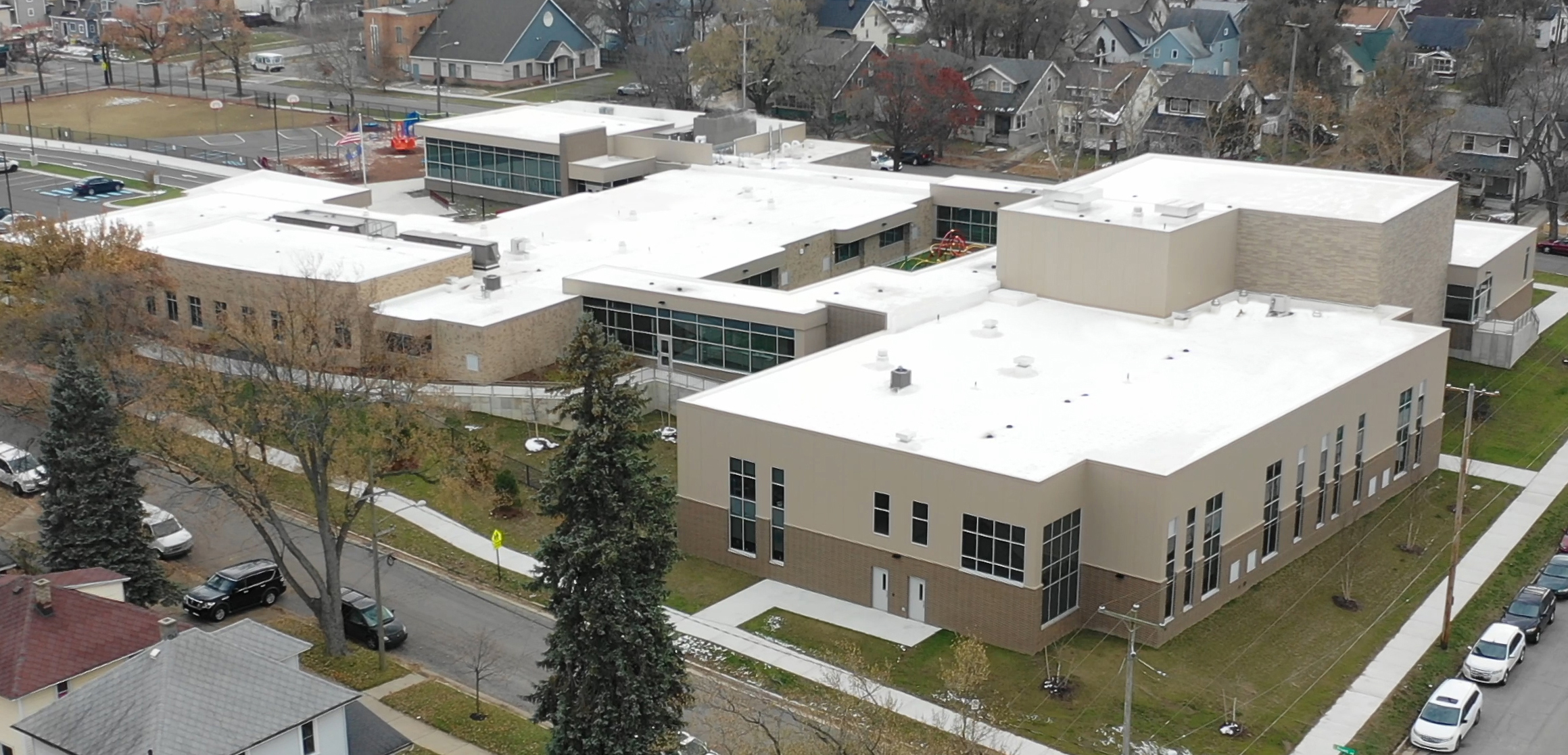
Photo courtesy of Duro-Last, Inc.
Studies show that cool roofing systems provide energy savings and other benefits when installed in cold climates. This cool roof was installed on an elementary school in Grand Rapids, Michigan.
White Roofs in Cold Climates
Myth: White roofs do not save energy in the winter and cause energy to be lost.
Reality: While it seems that a material that keeps buildings cool in summer would do the same in winter, the reality is not so simple. The amount of heat a dark roof could potentially gain in winter really isn’t all that significant compared to the amount of heat deflected in hotter seasons. Many environmental factors reduce the cooling impact of reflectivity in the winter. For example, the low angle of sun in winter allows for little solar heating potential. Plus, shorter and cloudier days reduce the time that solar heating can occur. In northern climates, numerous days with snow cover turn any roof white. We use energy at different times of the day in the winter—with peak heating demand occurring after the sun goes down when residents are home. Many commercial buildings have relatively low heating energy demand compared to cooling demand due to the heat generated by human activity and equipment. As a result, numerous studies have shown that cool roofing leads to net energy benefits across the country—even in the far north. This reality was discussed in a scientific journal report titled “Bright Is the New Black,” which concluded in part: “It has been shown...that in colder climates during winter, lower emissivity may actually be a positive attribute for white roofs with respect to avoiding any possible winter heat energy penalty. If a performance standard for emissivity is set for roof membranes, the possibility that a low emissivity may be desirable in cold climates to avoid any winter heat penalty should be considered.”xi,xii
PVC Composition
Myth: Phthalates are harmful to health.
Reality: Without phthalates, PVC products are rigid like pipe. Phthalates are added to provide flexibility for such products as tubing, banners, tarps, and roofing membranes. In 50 years of study and use, phthalates have had a strong safety record. Based on reliable peer-reviewed studies, phthalates have never been shown to cause harm to humans when used as intended. “Human health effects from exposure to low levels of phthalates are unknown. Some types of phthalates have affected the reproductive system of laboratory animals. More research is needed to assess the human health effects of exposure to phthalates.”xiii
Former Surgeon General C. Everett Koop said that there is no scientific evidence that phthalates are harmful to children or adults. And Moore further stated that there is a significant risk in replacing phthalates with chemicals that have not been as thoroughly tested and found as safe.
Cool Roofing Colors
Myth: Reflective cool roofs can only be white.
Reality: White is the most reflective color, but cool roofs come in many colors with varying degrees of solar reflectivity. Darker colors can be significantly reflective by the use of pigments that absorb in the visible light spectrum (thus giving it a color) but reflect in the near-infrared spectrum that is not visible to the naked eye. Since nearly 50 percent of the sun’s energy is in the near-infrared spectrum, cool colored pigments can be significantly more reflective than standard pigments.
Real Cost of Cool and Alternative Roofing
Myth: Cool roofing costs more than dark roofing.
Reality: Cool roofing incurs little or no increased costs. In fact, reflective roofing saves money over time. To determine the real cost of a roofing system, be sure to calculate all the factors, both up front and into the future.
Roofing Cost Calculator
Factors to consider when comparing the total life-cycle cost of a cool PVC membrane roof versus an alternative roofing system.
Installation
- Roof product cost
- Installation costs (labor and overhead)
- Tear-off costs (if required)
- Landfill costs
- PVC roofs can be returned to the manufacturer and recycled after their useful life on a rooftop.
- At least two PVC manufacturers have such programs.
- Building disruption costs
Long-term Durability
- Regular maintenance costs (over 20 years)
- Roof replacement costs (if life expectancy is less than 20 years)
Repairs
- Roof repair costs (estimated over 20 years)
- Interior damage repairs (estimated over 20 years)
Energy Savings
- Estimated energy savings (over 20 years)
- Energy rebates/incentives
Warranty
- Cost for 15-year warranty
Insulation and Radiant Barriers
Myth: Increased insulation and radiant barriers provide the same benefits as cool roofing.
Reality: While other measures may also cost-effectively save energy within a building, they do not provide the area wide cooling of cool roofs that helps reduce urban heat island effects. Studies show that insulation and cool roofing are important partners in a sustainable and high-performing roof system. Substituting one for the other will likely lead to sub-optimal outcomes.
Cool Vinyl Roofing and Sustainable Building Design
Vinyl may have a positive environmental profile when compared with other potential roofing materials. With metal, significant rock waste, tailings, and acid generation occurs from oxidation of sulfide materials during manufacture. The U.S. Environmental Protection Agency reported on this in a Technical Document titled: “Acid Mine Drainage Prediction.”xiv
Galvanized metal roofing creates zinc discharge in storm water runoff. This was demonstrated in “A Survey of Zinc Concentrations in Industrial Stormwater Runoff” by the Washington State Department of Ecology.xv
Clay tile requires massive excavation impacts, creating clay pits and soil erosion. A report on the environmental impact of clay harvesting from the International Journal of Innovative Research and Development states that: “The effects generated from clay harvesting can be multiple, such as soil erosion, air and water pollution, geo-environmental disasters, loss of biodiversity, and ultimately loss of economic wealth.”xvi
The issues with concrete are well-known. According to the EPA, “Cement plants are a significant source of sulfur dioxide, nitrogen oxide and carbon monoxide,” which are associated with a number of health and environmental impacts, including ground-level ozone, acid rain, global warming, water quality deterioration, visual impairment, and other impacts. These impacts were listed in a paper titled: “Cement Manufacturing Enforcement Initiative.”xvii
Slate quarrying can cause broad environmental damage. According to guidelines from the Missouri Dept. of Natural Resources, “Rock quarry and stone operations deal with many things that can affect the environment. Materials such as dust, contaminated storm water and used oil can harm the environment and people if they are not properly managed.”xviii Also, the report states, “Quarrying and stone processing facilities generate dust, also called particulate matter, with diameter less than or equal to 10 micrometers. Regulators call this dust PM10. PM10 can cause lung damage.”
One of the major sustainable benefits of PVC roofing is that it is inherently recyclable. Vinyl materials can be reprocessed and recycled repeatedly into useful products. More than one billion pounds of post-industrial and post-consumer vinyl is recycled annually in the United States, and that volume is growing.
PVC is the only roofing material proven to be recyclable on a large scale back into new roofing products. PVC roofing materials have been recycled in the United States and Europe for more than 20 years. Useful products such as commercial flooring, concrete expansion joints, and roofing walkpads are made from recycled vinyl.
Green Building Rating Systems
As the green movement grew, sustainability-minded architects and other stakeholders wondered how vinyl and PVC fit into the puzzle. The U.S. Green Building Council (USGBC) created a LEED Technical and Scientific Advisory Committee PVC Task Group that undertook a two-year study of PVC building products and determined that neither vinyl nor any competing material deserves to be eliminated. Regarding environmental impact, the final report states that: “The evidence indicates that a credit that rewards avoidance of PVC could steer decision makers toward using materials that are worse on most environmental impacts.” xix
On human health risk, it states that: “Data on end-of-life emissions are highly uncertain and therefore there is a wide range of exposure possibilities.”
In fact, PVC cool roofing systems can help architects reach their LEED goals. Some possible credit considerations for LEEDv4.1 BD+C: New Construction and LEED ID+C: Commercial Interiors associated with a PVC cool roofing system include:
Some possible credit considerations for LEED O+M: Existing Buildings associated with a PVC cool roofing system include:
The Green Globes rating system includes a cool roof credit for roofs that have a minimum solar reflectance of 0.65 and a minimum thermal emittance of 0.90. One to 10 points are awarded based on the percent of the roof covered with cool roof material. A project can earn a total of 350 points in the Energy category, under a total of 1,000 points for the whole rating program. Further details on rating systems, codes, and standards are available on the website of the Cool Roof Rating Council.xx
How to Select a Cool Roof
There are some key questions you should ask when deciding on the best system for your needs. You may have other considerations unique to certain projects, but these are critical:
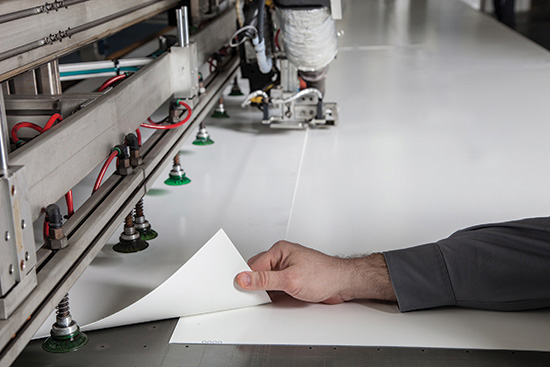
Photo courtesy of Duro-Last, Inc.
When a cool roofing system is being specified, the ability of a company to prefabricate the system in a factory-controlled setting should be a factor. These prefabricated systems install quicker on site and require less on-site labor.
- Prefabrication: Can the membrane and roofing accessories for penetrations be prefabricated? One of the biggest issues in construction today is a shortage of skilled labor. To be a truly durable and thus “green” system, it must be installed correctly with a minimum of installation errors. The extent of customization/pre-manufacturing the supplier or manufacturer can offer should factor highly in your specification. Does the performance of the whole system exceed the sum of the individual components? Do the components work in harmony?
- Membrane: What is the base material made of? And how is it made? As noted earlier in the article, some materials have a lower carbon footprint, last longer, and provide more benefits. Will temperature, moisture, and dirt affect integrity? What are the code considerations? What is the impact of the weight of the roofing? Are there structural concerns? What are the aesthetic issues?
- Complete Systems: Are major components supplied by single or multiple suppliers? For the highest performance and lowest chance for error and incompatibility, a single supplier should supply all parts. This ties into a major movement in the increasingly complex world of building materials. Whereas past generations of architects, specifiers, engineers, contractors, and workers had a limited number of materials to deal with, new generations must contend with hundreds or thousands of materials and processes, some of which are not compatible. Systems manufactured or tested by a single supplier decrease that risk.
- Flashing Methods: What manner, method, and materials are used for waterproofing and attachment method(s) used at transition points with deck sheets, stacks, curbs, parapets, etc.? The quality of manufacture and installation are essential here. This is where most roofing failures occur due to expansion/contraction, building movement, and so on. Ask if the flashings are prefabricated in a controlled factory setting, which is the preferred method. Or, are they fabricated in the field, where errors can be more likely? Are the flashings integrated with the system? And of utmost concern: Are the flashings included in the warranty?
- Warranties: There is probably no other issue as controversial as warranty coverage. According to research, 77 percent of building owners say this is the most frequently unmet need (SPRI Research by Drucker Worldwide 2000). As the saying goes: “The large print giveth, the small print taketh away.” For clues to the weaknesses of a system, look at the exclusions in the warranty. In particular, watch for fine print, which will suggest the weaknesses of the system. And what about extra costs? If there is no such thing as a free warranty, the question should be, “Why not?” Make sure the warranty can be transferred with ownership. Take note of exclusions. Some commercial roofing warranties specifically exclude ponding water on the roof, for instance. The length of time for the warranty should be realistic. If the company has only been in business for a few years or only manufactured roofing materials, offering a warranty of several decades should raise red flags of skepticism. If the material has been in existence for a long time, and the company has a long history and long track record, the warranty will have more meaning. Another consideration when researching warranty coverage is the manufacturer’s care and maintenance guidelines. Be sure to request a copy and review it before making a purchase because some manufacturers require extensive care and maintenance for their warranties to remain valid.
- Services Available: Finally, what services does the manufacturer or supplier offer the architect? Manufacturers work with the designers to provide the best solution for each roofing need. These services could also include code information, drawings, and documentation. Your goal is to serve your clients with most clarity and with least liability.
Conclusion
Architects have long been leaders in reducing the heating and air-conditioning burdens caused by buildings. Installing a cool, reflective roof deflects solar heat from reaching into the building, thus reducing cooling needs. The use of PVC for the membrane adds to the sustainability of the roof by providing a long-lived material that will not only last up to 20 years or longer, but can be recycled at the end of that use. The use of a PVC membrane for a cool roof system can go a long way in meeting the goals of a sustainability-minded architect or specifier.
Endnotes
I climate.nasa.gov/causes
II archive.defense.gov/pubs/150724-congressional-report-on-national-implications-of-climate-change.pdf
III en.wikipedia.org/wiki/Intergovernmental_Panel_on_Climate_Change
IV duro-last.com/pdf/marketing/dl_university/whitepapers/peak_demand_article.pdf
V www.coolrooftoolkit.org/wp-content/uploads/2015/07/Princeton-Paper-1-experimental-as-published-1.pdf
VI www.greenspacehealth.com/wp-content/uploads/2013/01/urban-heat-island-epa.jpg
VII heatisland.lbl.gov
VIII www.greenbuildingsolutions.org/Main-Menu/Home/Modern-Materials-Archive/Energy-Efficiency/The-Cool-Roof-Phenomenon.html
IX coolroofs.org
X www.energystar.gov/productfinder/product/certified-roof-products/
XI iopscience.iop.org/article/10.1088/1748-9326/7/1/014029/meta;jsessionid=2B65F8F3857B40DEA1656521FFAB705B.c5.iopscience.cld.iop.org
XII www.nasa.gov/topics/earth/features/ny-roofs.html
XIII www.cdc.gov/biomonitoring/Phthalates_FactSheet.html
XIV water.epa.gov/polwaste/nps/upload/amd.pdf
XV fortress.wa.gov/ecy/publications/publications/0603009.pdf
XVI www.academia.edu/10257976/Environmental_Impacts_of_Clay_Harvesting
XVII www2.epa.gov/enforcement/cement-manufacturing-enforcement-initiative
XVIII dnr.mo.gov/pubs/pub340.pdf
XIX www2.buildinggreen.com/article/usgbc-releases-draft-report-pvc
XX coolroofs.org/documents/Cool_Roof_Ratings_Codes_and_Programs021710.pdf
 |
Known as the “World’s Best Roof®,” a Duro-Last® roof is perfect for any flat, low-sloped, new or retrofit application. Precision-fabricated accessories combined with prefabricated deck sheets or roll goods allow for a watertight roof that doesn’t sacrifice aesthetics. www.duro-last.com |










